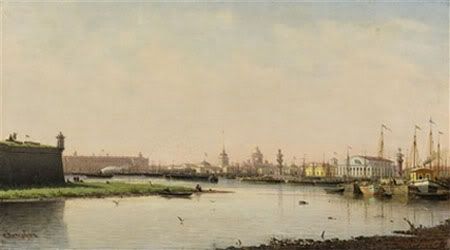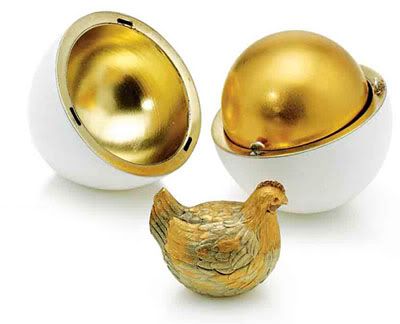 |
I recently wrote about Russia:
Strange and tragic sets of circumstances caused Russia to endure debilitating communism for three quarters of a century.But I continued that Russian is reviving its iconic cultural presence. Russian native turned American citizen Mikhail Baryshnikov is auctioning off one of his paintings to finance his cultural center in New York, the Baryshnikov Arts Center. The painting is "View of St. Petersburg" by Russian painter Petr Petrovich Vereshchagi, dated around 1836. The European impressionist movement seemed to have bypassed Vereshchagi, whose realistic rendition of St. Petersburg Baryshnikov describes as "extraordinarily detailed," with a "very recognizable panoramic view of St. Petersburg."
Back in Moscow, and in time for Easter, the museum in the formidable Kremlin Armory is exhibiting six Fabergé eggs from the House of Fabergé, which was started by the 19th century Russian jeweler/goldsmith Carl Fabergé. Although the original Fabergé line was discontinued in 1918 by the Bolsheviks, modern style Fabergé eggs attract enthusiasts and designers.
Here is what Wikipedia says on the the egg that inspired all the rest:
The story began when Tsar Alexander III decided to give his wife the Empress Maria Fedorovna an Easter Egg in 1885, possibly to celebrate the 20th anniversary of their betrothal. It is believed that the Tsar’s inspiration for the piece was an egg owned by the Empress’s aunt, Princess Wilhelmine Marie of Denmark, which had captivated Maria’s imagination in her childhood. Known as the Hen Egg, it is crafted from gold. Its opaque white enameled ‘shell’ opens to reveal its first surprise, a matte yellow gold yolk. This in turn opens to reveal a multi-coloured gold hen that also opens. It contains a minute diamond replica of the Imperial Crown from which a small ruby pendant was suspended. Unfortunately, these last two surprises have been lost.
Empress Maria was so delighted by this gift that Alexander appointed Fabergé a ‘goldsmith by special appointment to the Imperial Crown’. He commissioned another egg the following year. However, after that, Peter Carl Fabergé, who headed the House, was apparently given complete freedom for future Imperial Easter Eggs, as from this date their designs become more elaborate. According to the Fabergé family tradition, not even the Czar knew what form they would take: the only stipulation was that each one should contain a surprise. Following the death of Alexander III on November 1, 1894, his son presented a Fabergé egg to both his wife, the Empress Alexandra Fedorovna, and to his mother, the Dowager Empress Maria Fedorovna.
 |
wife the Empress Maria Fedorovna on Easter 1885